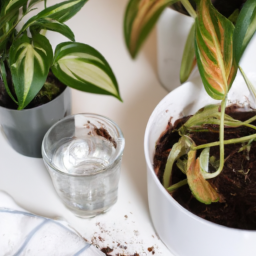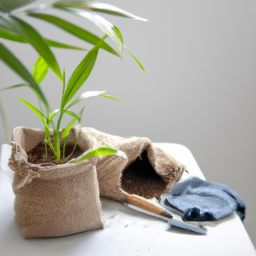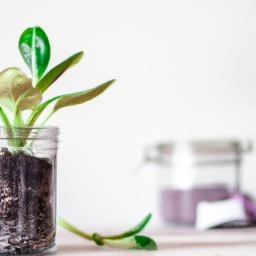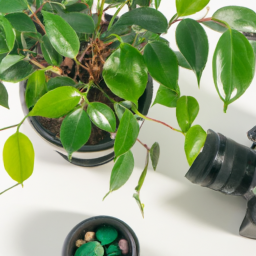
Hey there, fellow plant enthusiasts! Are you ready to embark on the exciting journey of plant parenthood? If you’re a newbie to the world of indoor plants and looking to give your green thumb a go, you’ve come to the right place. In this blog post, we’ll be delving into the essentials of Plant Parenthood 101: Nurturing Your First Indoor Plant. Whether you’re a total beginner or have had a few failed attempts in the past, we’ve got you covered with all the tips and tricks you need to ensure your new leafy friend thrives in its new home. So, let’s roll up our sleeves, grab our watering cans, and get ready to dive into the wonderful world of indoor plant care!
Choosing the Right Indoor Plant for Beginners
So, you’ve decided to become a plant parent and bring some greenery into your home. Congratulations! Indoor plants not only add beauty to your space but also provide numerous health benefits. However, as a beginner, it’s essential to choose the right indoor plant that suits your lifestyle and level of expertise. In this guide, we will walk you through the process of selecting the perfect plant for your indoor garden.
Consider Your Environment
The first step in choosing the right indoor plant is to consider the environment in which it will thrive. Different plants have varying requirements for light, temperature, and humidity. Assess the conditions of your home or office space where you plan to keep the plant.
If you have a well-lit room with plenty of natural sunlight, you can opt for plants that require bright light, such as succulents, cacti, or spider plants. On the other hand, if your space has limited access to sunlight, you may want to consider low-light tolerant plants like pothos, snake plants, or peace lilies.
Temperature and humidity are equally important factors to consider. Some plants thrive in warm and humid environments, while others prefer cooler and drier conditions. Make sure to choose a plant that can adapt to the temperature and humidity levels of your home.
Assess Your Commitment Level
Another crucial aspect to consider when choosing an indoor plant is your commitment level. Different plants have different care requirements, and it’s important to select one that aligns with the amount of time and effort you can dedicate to plant care.
If you’re a busy individual with a hectic schedule, low-maintenance plants like ZZ plants, pothos, or snake plants are excellent choices. These plants can tolerate occasional neglect and can thrive with minimal care.
However, if you’re someone who enjoys spending time tending to plants and has a green thumb, you might want to consider more demanding plants like orchids or ferns. These plants require more attention, including regular watering, fertilizing, and monitoring of environmental conditions.
Consider Your Space
The available space in your home or office will also play a role in determining the right indoor plant for you. Some plants grow tall and wide, while others remain compact and bushy. Consider the size and layout of your space before choosing a plant.
If you have limited space, opt for smaller plants like succulents, air plants, or herbs that can be placed on windowsills or shelves. Hanging plants like pothos or spider plants are also great options for vertical gardening, allowing you to make the most of your space.
For larger spaces, you can go for statement plants like fiddle leaf figs, monstera deliciosas, or yucca plants. These plants not only add a touch of grandeur to your space but also serve as focal points in your indoor garden.
Remember to consider the growth habits of the plants you choose. Some plants, like trailing vines, may require additional support or trellises to prevent them from sprawling all over your space.
By considering your environment, commitment level, and available space, you can successfully choose the right indoor plant that suits your needs and preferences. Remember that each plant is unique, and it’s essential to research and understand its specific care requirements to ensure its well-being. Happy plant parenthood!

Essential Tips for Nurturing Your First Indoor Plant
Welcome to the world of plant parenthood! Taking care of indoor plants can be a rewarding and fulfilling experience. Not only do they add beauty and life to your living space, but they also provide numerous health benefits. Whether you have a green thumb or are a complete novice, this step-by-step guide will help you nurture your first indoor plant with ease.
Choosing the Right Plant
The first step in plant parenthood is selecting the right plant for your indoor space. Consider factors such as lighting conditions, temperature, and the amount of care you are willing to provide. Here are some popular indoor plants that are suitable for beginners:
1. Snake Plant (Sansevieria): Snake plants are known for their resilience and ability to thrive in low-light conditions. They require minimal watering and are excellent air purifiers.
2. Pothos (Epipremnum aureum): Pothos is a versatile plant that can adapt to various light conditions. It is low-maintenance and has beautiful trailing vines.
3. Spider Plant (Chlorophytum comosum): Spider plants are great for beginners as they are hardy and can tolerate a wide range of conditions. They also produce baby spiderettes that can be propagated into new plants.
Once you have chosen your plant, it’s time to create the perfect environment for it to thrive.
Providing the Ideal Growing Conditions
Lighting: Most indoor plants require bright, indirect light. Place your plant near a window where it can receive a few hours of sunlight each day. Avoid exposing it to direct sunlight, as it can scorch the leaves.
Temperature: Indoor plants generally prefer temperatures between 60-75°F (15-24°C). Keep them away from drafts and extreme temperature changes, such as near air conditioning vents or radiators.
Humidity: Many indoor plants thrive in humid environments. Increase humidity levels by placing a tray of water near the plant or using a humidifier. Misting the leaves occasionally can also help.
Watering: The key to successful watering is finding the right balance. Overwatering can lead to root rot, while underwatering can cause the plant to wither. Check the moisture level of the soil regularly by sticking your finger about an inch deep. If it feels dry, it’s time to water. Remember, different plants have different watering needs, so research your specific plant’s requirements.
Fertilizing: Indoor plants benefit from regular fertilization. Use a balanced, water-soluble fertilizer and follow the instructions on the packaging. Be cautious not to over-fertilize, as it can harm the plant.
Regular Maintenance and Troubleshooting
Pruning: Regular pruning helps your indoor plant maintain its shape and promotes healthy growth. Trim any yellow or dead leaves, as they can attract pests or diseases.
Pest Control: Keep an eye out for common indoor plant pests such as aphids, spider mites, and mealybugs. If you notice any signs of infestation, treat the plant with a mild insecticide or try natural remedies like neem oil or a soap-water solution.
Disease Prevention: Indoor plants are susceptible to diseases caused by overwatering, poor air circulation, or fungal infections. Ensure good air circulation around the plant, avoid overwatering, and promptly remove any diseased leaves or stems to prevent the spread of infection.
Repotting: As your indoor plant grows, it may outgrow its current pot. Repotting allows the roots to spread and provides fresh nutrients. Choose a pot slightly larger than the current one, use well-draining soil, and be gentle when handling the plant’s roots.
Remember, each plant is unique, and it may take some trial and error to find the perfect care routine. Observe your plant closely, and adjust the conditions accordingly. With time and patience, you’ll become a confident plant parent, nurturing your indoor plants into flourishing green companions!

Plant Parenthood 101: Nurturing Your First Indoor Plant
3. Common Mistakes to Avoid in Plant Parenthood
So, you’ve decided to embark on the journey of plant parenthood and bring an indoor plant into your home. Congratulations! Indoor plants not only add beauty and freshness to your living space but also provide numerous health benefits. However, it’s important to be aware of common mistakes that many first-time plant parents make. By avoiding these pitfalls, you can ensure the healthy growth and longevity of your indoor plant. Let’s dive into the most common mistakes and how to avoid them.
1. Overwatering
One of the most common mistakes beginners make is overwatering their indoor plants. While it’s essential to provide your plant with adequate hydration, too much water can lead to root rot and other fungal diseases. Each plant has different water requirements, so it’s crucial to understand the specific needs of your indoor plant.
To avoid overwatering, always check the moisture level of the soil before watering. Stick your finger about an inch deep into the soil; if it feels dry, it’s time to water. Additionally, ensure that your plant’s pot has proper drainage to prevent water from accumulating at the bottom.
Remember, it’s better to underwater than overwater. Most indoor plants can tolerate slight dryness, but they struggle to recover from excessive moisture.
2. Lack of Adequate Lighting
Another common mistake is not providing enough light to your indoor plants. Light is essential for photosynthesis, the process by which plants convert light energy into food. Without adequate light, your plant may become weak, leggy, and struggle to grow.
Place your indoor plant in a location where it can receive bright, indirect sunlight for at least 6-8 hours a day. South or west-facing windows are usually the best spots. If natural light is limited in your home, consider using artificial grow lights specifically designed for indoor plants.
Keep in mind that different plants have different light requirements, so research your specific plant’s needs to ensure it receives the right amount of light for optimal growth.
3. Ignoring Temperature and Humidity
Temperature and humidity play a significant role in the health of your indoor plant. Many beginners overlook these factors, leading to stress and poor growth for their plant.
Most indoor plants thrive in temperatures between 60-75°F (15-24°C). Avoid placing your plant near drafts, air conditioning vents, or heaters, as extreme temperature fluctuations can harm your plant.
Humidity is also crucial, especially for tropical plants. If the air in your home is dry, consider using a humidifier, placing a tray of water near the plant, or misting the leaves regularly to increase humidity levels.
By paying attention to temperature and humidity, you can create an environment that mimics your plant’s natural habitat, promoting healthy growth.
Plant parenthood can be a rewarding and fulfilling experience, but it does come with its challenges. By avoiding these common mistakes, you are well on your way to becoming a successful plant parent. Remember to research the specific needs of your indoor plant, observe it regularly, and adjust your care routine accordingly. With patience, love, and a little knowledge, your indoor plant will thrive and bring joy to your home for years to come.
Here are the Essential Points
So, you’ve decided to become a plant parent and bring some greenery into your indoor space – congratulations! But wait, before you jump in headfirst, it’s important to understand the basics of plant parenthood and how to nurture your first indoor plant. Don’t worry, we’ve got you covered with this Plant Parenthood 101 guide.
First things first, choose a plant that suits your lifestyle and environment. Are you a busy bee or a forgetful waterer? Opt for low-maintenance plants like snake plants or pothos. If you have a sunny spot near a window, consider plants that thrive in bright light, such as succulents or spider plants. Once you’ve found the perfect plant, it’s time to create a cozy home for it. Choose a pot with drainage holes to prevent waterlogging, and use well-draining soil to ensure healthy root growth.
Now that your plant has a comfy home, let’s talk about watering. Overwatering is a common mistake for newbie plant parents, so it’s crucial to find the right balance. Stick your finger about an inch into the soil – if it feels dry, it’s time to water. But if it’s still moist, hold off for a few more days. Each plant has different water requirements, so it’s essential to research your specific plant’s needs. Lastly, don’t forget to give your plant some TLC. Dust off its leaves regularly, rotate it every few weeks to ensure even growth, and keep an eye out for any signs of pests or diseases.
Remember, plant parenthood is a journey of learning and adapting. Don’t get discouraged if you encounter some bumps along the way. With a little patience, love, and a green thumb mindset, you’ll soon become a pro at nurturing your indoor plants. Happy plant parenting!
FAQ Roundup:
Q1: What are some beginner-friendly indoor plants that I can start with?
A1: If you’re new to indoor plants, there are several easy-to-care-for options that are perfect for beginners. Some popular choices include pothos, spider plants, snake plants, and peace lilies. These plants are known for their resilience and ability to thrive in various indoor environments.
Q2: How often should I water my indoor plants?
A2: The watering frequency for indoor plants can vary depending on the type of plant, the size of the pot, and the environmental conditions. As a general rule, it’s best to allow the top inch of soil to dry out before watering again. Overwatering can lead to root rot, so it’s important to strike a balance and avoid letting the soil become too soggy.
Q3: What kind of lighting do indoor plants need?
A3: Indoor plants have different lighting requirements, but most of them thrive in bright, indirect light. Place your plants near a window where they can receive filtered sunlight throughout the day. Avoid exposing them to direct sunlight, as it can scorch their leaves. If you have low-light areas in your home, there are also plants that can tolerate and even thrive in such conditions, like ZZ plants and pothos.
Q4: How do I know if my indoor plant needs fertilizer?
A4: Indoor plants generally benefit from regular fertilization during their active growing season, which is usually spring and summer. Signs that your plant may need fertilizer include slow growth, pale leaves, or a lack of new growth. You can use a balanced, water-soluble fertilizer specifically formulated for indoor plants. Follow the instructions on the packaging for the correct dosage and frequency.
Q5: How can I prevent common pests from infesting my indoor plants?
A5: Pests like aphids, spider mites, and fungus gnats can be a nuisance to indoor plants. To prevent infestations, regularly inspect your plants for any signs of pests, such as tiny insects, webbing, or yellowing leaves. If you notice any issues, isolate the affected plant and treat it with an appropriate insecticidal soap or oil. Additionally, maintaining good plant hygiene, providing adequate airflow, and avoiding overwatering can help deter pests.
Dr. Olivia Green is a botanist with over two decades of experience in indoor plant cultivation. She holds a Ph.D. in Plant Biology and has dedicated her career to researching plant behavior in controlled environments. Dr. Green is passionate about helping plant enthusiasts master the art of indoor gardening through her extensive knowledge and practical insights.


